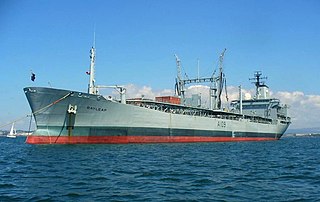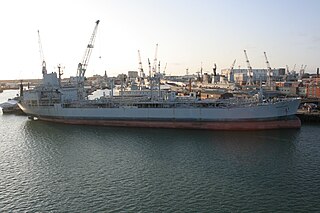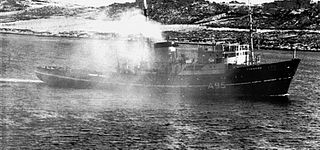
The Royal Fleet Auxiliary (RFA) is a naval auxiliary fleet owned by the UK's Ministry of Defence. It is a component of His Majesty's Naval Service and provides logistical and operational support to the Royal Navy and Royal Marines. The RFA ensures the Royal Navy is supplied and supported by providing fuel and stores through replenishment at sea, transporting Royal Marines and British Army personnel, providing medical care and transporting equipment and essentials around the world. In addition the RFA acts independently providing humanitarian aid, counter piracy and counter narcotic patrols together with assisting the Royal Navy in preventing conflict and securing international trade. They are a uniformed civilian branch of the Royal Navy staffed by British merchant sailors. The RFA is one of five RN fighting arms.

RFA Orangeleaf was a Leaf-class fleet support tanker of the Royal Fleet Auxiliary.

RFA Fort Austin is a retired British Fort Rosalie-class dry stores ship of the Royal Fleet Auxiliary.

RFA Gold Rover was a small fleet tanker of the Royal Fleet Auxiliary and one of five Rover-class ships that were designed by the Admiralty, all of which were built at the Swan Hunter shipyard.

RFA Bayleaf (A109) was a Leaf-class support tanker of the Royal Fleet Auxiliary.

RFA Fort Rosalie was the lead ship of her class of Royal Fleet Auxiliary fleet replenishment ships. Fort Rosalie was originally named RFA Fort Grange, but was renamed in May 2000 to avoid confusion with the now-decommissioned RFA Fort George. On 31 March 2021, the ship was withdrawn from service.

RFA Oakleaf (A111) was a Leaf-class fleet support tanker, formerly of the Royal Fleet Auxiliary, and the second ship to bear the name.

RFA Black Rover was a Rover-class small fleet tanker of the British Royal Fleet Auxiliary. She was designed to replenish ships underway at sea with fuel, fresh water, and stores in all weather conditions. She had a helicopter deck served by a stores lift and was capable of conducting helicopter replenishment. Displacing 16,160 tonnes, she was powered by twin diesels and has a ship's company of 60.

RFA Brambleleaf (A81) was a Leaf-class support tanker of the Royal Fleet Auxiliary. Originally built as MV Hudson Deep she was chartered by the Ministry of Defence in 1980.

RFA Olna (A123) was the third and final of the three Ol-class "fast fleet tanker" of the Royal Fleet Auxiliary. Olna saw service in the Falklands War.

RFA Tidespring (A75) was a Tide-class replenishment oiler of the Royal Fleet Auxiliary. As a replenishment oiler, her main purpose was to refuel other ships. The ship had a long career in the RFA, entering service in the early 1960s, and finally being decommissioned in 1991.

RFA Engadine (K08) was a helicopter support ship of the Royal Fleet Auxiliary.

RFA Green Rover (A268) was a Rover-class fleet support tanker of the Royal Fleet Auxiliary, built by Swan Hunter Shipbuilders on the River Tyne, UK and completed in 1969. After decommissioning in 1992 she was sold to the Indonesian Navy and renamed KRI Arun (903)

RFA Resource was an armament stores ship of the Royal Fleet Auxiliary.

RMAS Typhoon (A95) was an ocean-going tug of the Royal Maritime Auxiliary Service (RMAS). She was designed for ocean towing, rescue, salvage and fire-fighting. She was the first ship to leave the United Kingdom ahead of the task force for the South Atlantic during the 1982 Falklands War. She had a fishery protection role in the Cod Wars.

RFA Wave Ruler is a Wave-class fast fleet tanker of the Royal Fleet Auxiliary (RFA) of the United Kingdom tasked with providing fuel, food, fresh water, ammunition and other supplies to Royal Navy vessels around the world.

RFA Wave Knight is a Wave-class fast fleet tanker of the Royal Fleet Auxiliary (RFA) of the United Kingdom tasked with providing fuel, food, fresh water, ammunition and other supplies to Royal Navy vessels around the world.

RFA Plumleaf (A78) was a Leaf-class support tanker of the Royal Fleet Auxiliary of the United Kingdom.

RFA Pearleaf (A77) was a Leaf-class support tanker of the Royal Fleet Auxiliary of the United Kingdom. She was the second ship to bear the name.

RFA Tidespring is a Tide-class replenishment tanker of the British Royal Fleet Auxiliary (RFA). Built by DSME in 2016, the ship entered service with the Royal Fleet Auxiliary in November 2017.




















